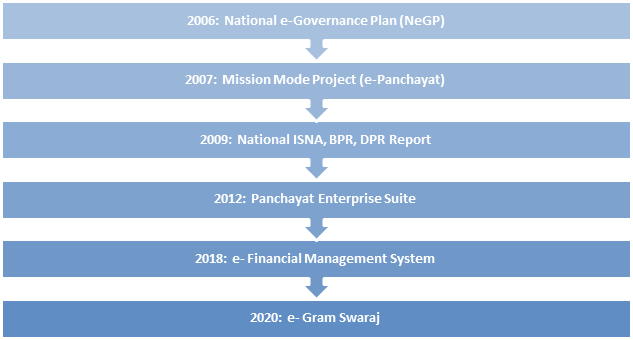About Panchayati Raj Institutions (PRIs)
-
- The 73rd Amendment granted constitutional status to PRIs.
- It provided a framework for devolution of power and resources.
- Added Part IX (The Panchayats) to the constitution covering Article 243 to 243(O)
- Added Eleventh Schedule covering 29 Subjects within the functions of the Panchayats.
- Some provisions are:
- A three-tier system of panchayats.
- Reservation of seats for scheduled castes, scheduled tribes, and women in panchayats at all levels.
- Constitution of State Finance Commissions to review the financial position of panchayats and to make recommendations.
- Establishing a State Election Commission to conduct elections to local governments at three tiers.
Objectives

Positive working of PRIs:
-
- Participative democracy: reduced the distance between citizen and government.
- For example- Hiware Bazar village, Maharashtra has improved living standards through participatory decision-making.
- Empowering Vulnerable sections: 33% reservation for Women, SC and ST.
- 6% of total Panchayati Raj Institution representatives are women.
- Transparency: The Gram Sabha is a mechanism of Social Audit.
- Effective public service deliverythrough bottom-up approach.
- For example– effective implementation of MGNREGA.
Challenges faced by PRIs:
-
- The “3F” problems: Finance, Functions, and Functionaries

-
- Lack actual participation of women and disadvantaged groups:Concept of Panchayat pati, where real power is exercised by the male guardian.
- Ineffective District Planning committees (DPC): lack a robust institutional framework, as inadequate staffing, insufficient infrastructure, and lack of dedicated resources.
- Lack empowerment: Prevalence of one-size fit all approach and localised solutions not encouraged.
Role of Gram Sabha in Local Self Governance
About Gram Sabha:
-
- Article 243 (b) defines the gram sabha as which consists of persons registered on the electoral rolls.
- State legislature has the power to empower Gram Sabha.
- It works as a deliberative body to uphold the responsibility of Gram Panchayat.
Role and functions:
-
- Implements Program & Schemes of the Panchayat.
- Identification of beneficiaries for various government schemes
- Promotes Mass Education & Family Welfare
- Fosters Social Unity & Harmony in the village.
- Ensures Accountability of Gram Panchayat.
- Considers matters related to taxation & revenue.
- Discusses issues referred by the Gram Panchayat for decision-making.
Gram Sabha, MGNREGA and social audit
About Social Audit
-
- Means of continuous public vigilance and to ensure public accountability in implementation of projects, laws and policies.
- Provided under MGNREGA Act, 2005.
- Checks quality of work, financial misappropriation, and procedural deviations.
Legal Framework
-
- Section 17 of MGNREGA mandates gram sabhas to monitor work execution.
- Audit of Scheme Rules, 2011, developed by MoRD & CAG, set procedures for social audits.
- Social Audit Units (SAUs) operate independently with 0.5% of MGNREGA state expenditure.
- Centre can withhold MGNREGS funds if states fail to conduct social audits.
Achievements:
-
- Kerala leads with 100% coverage of gram panchayats in social audits.
- States with over 50% coverage: Bihar (64.4%), Gujarat (58.8%), J&K (64.1%), Odisha (60.42%), UP (54.97%).
- 40%+ coverage states: Telangana (40.5%), Himachal Pradesh (45.32%), Andhra Pradesh (49.7%).
- Low coverage poll-bound states: Madhya Pradesh (1.73%), Mizoram (17.5%), Chhattisgarh (25.06%), Rajasthan (34.74%).
Challenges:
-
- Low awareness among local communities.
- Lack funding for Social Audit Units.
- Political interference affecting impartiality.
- Poor cooperation between implementing authorities & audit units.
- Lack of follow-up on audit findings.
- Threats & harassment to social auditors and whistle-blowers.
Digitalization of PRIs (e-panchayat)
Evolution:

Key Initiatives:
-
- e-Panchayat Mission Mode Project (MMP): Automating Panchayat operations, like planning, budgeting, accounting, and monitoring to make them more transparent and effective.
- E-GramSwaraj Portal: A work-based application for PRIs. It integrates planning, budgeting, accounting, asset management, and online payments into a single digital platform.
- Bharat Net project: To create network to connect all the GPs by broadband in the country.
- Integration with Public Financial Management System (PFMS): To enable real-time payments to vendors and service providers.
Related facts:
-
- Approximately 2.49 lakh Gram Panchayats have uploaded their GPDPs for the 2023-24 period on the eGramSwaraj portal.
- Around 2.30 lakh Gram Panchayats have completed online transactions for the 15th Finance Commission grants for the 2023-24 fiscal year.
- 19 lakh GPs have taken steps for payments through Public Finance Management System (PFMS).
Challenges in Digitalizing PRIs:
-
- Infrastructure deficiencies
- Capacity and skill gaps
- Digital divide
- Political and administrative interference
Way Forward:
-
- Infrastructure enhancement
- Capacity building
- Bridging the digital divide
- Ensuring autonomous and effective local governance system

